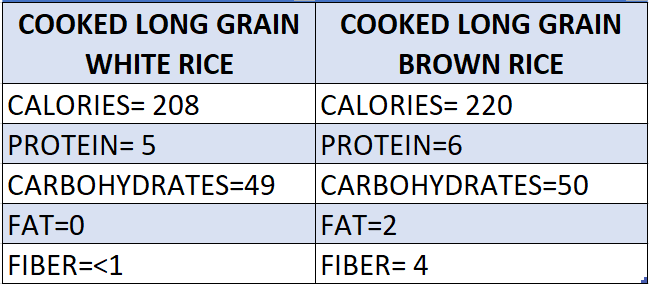Rice is the staple crop which is grown all over the world. It comes in colors, shapes, and sizes but most popular is white rice and brown rice. White rice is pulverized and processed with the hull (the hard protective coating), bran (outer layer), and germ (nutrient-rich core). Brown rice is a whole grain which essentially contains all types of grains such as fiber, bran, nutritious germ and where the hull (hard protective coating) is removed. Many health communities choose white rice as an unhealthy option, as it lacks many vitamins and minerals that are present in brown rice.
The most traditional consumed type of rice is white rice, but the widely recognized as a healthier option is the brown rice. White rice leaves only few nutrients and minerals because it is a refined grain that these nutritious parts are removed, where the brown rice is considered to be a healthy source as it provides several minerals and vitamins and proteins and it is fully contained of bran and germ in care of their future attack diseases by avoiding the white rice.
Here the article provides you to decide whether white rice or brown rice is good or bad to stay healthy
Brown rice is very healthier than white rice as it has a big advantage in the nutritional value. It has important fiber, antioxidants and also the vitamins and minerals. While white rice is essential with low nutrients and rich in calories. The list of the vitamins and minerals in the brown and white rice.
Comparison of minerals and vitamins in brown rice and white rice
For Diabetes
Brown rice is considered as the low GI (glycemic index) and tells that how quickly a food raises the blood sugar after eating. The whole grains are of minerals which are associated with low risk of cancer, heart disease, and strokes. It is used as a healthy diet as it contains extra nutrients, proteins, and fiber that provide health benefits
- Controls the blood sugar levels
- Cholesterol-lowering in the body
- Helps you feel active
White rice, on the other hand, increases the risk of high blood sugar levels and type2 diabetes. This is due to the high GI ( glycemic index) which means it bears quickly into blood sugar. The Glycemic Index is a measure that how a body can fastly convert into sugars that are absorbed by the blood. The White rice has a GI of 64 and the higher GI can cause rapid attacks on the body.
For Immune system
Brown rice contains a source of selenium which helps in the functioning of the immune system, thyroid hormone production, and antioxidant production and even magnesium help development of bones and muscles. As the brown rice is rich to offer nutrients and give health benefits, the half cup is the maximum serving quantity of cooked brown rice.
White rice contains folic acid (folate) which is suggested for the pregnant ladies and also the women who are breastfeeding. This folic acid helps the pregnant ladies in the growth of DNA and genetics and suppression of cell division. White rice generally includes calcium and iron from artificial dugout.
Reduce Weight
Consuming Brown rice instead of white rice can reduce weight, the circumference of hips, thighs, and waist. According to the researchers, people who consumed more grains weighed less weight as compared to the people who consumed a few whole grains.
White rice is a refined grain if consumed increases in weight gain, belly fat, and obesity. It appears to be neither harmful nor favorable to weight loss. It does not affect weight loss and maintenance very much.

- Brown rice is the whole-grain rice with the inedible outer protective coating removed.
- White rice is processed that it alters the flavor and appearance of rice which helps in preventing spoilage. After the rice is finely polished it results in seeds with a bright, white and shiny aspect.
The nutritional value of the 100gms of brown rice and white Rice as follows

CONCLUSION:
Anywhere else in the world, rice is measured by the share of harvested area crop and also the share of rice in calorie consumption. The world’s largest rice producers are India and China. Rice may be in different colors, shapes, and sizes in which the most populous rice is the brown and white rice. Brown rice includes anti-nutrient phytic acid than white rice. Eating brown rice lowers the blood sugar level and reduce type 2 diabetes, whereas eating white rice can increase the risk of type2 diabetes.
Rice is mainly formulated with carbohydrates. Some type makes an unhealthy stake in blood sugar levels, making them unhealthy for the diabetics. White rice has no fiber, whereas Brown rice is of a good source. These both types of rice contain various amount of starch in it, which promote good health. High consumption of white sticky rice can increase diabetes. In taking rice from the polluted areas must be avoided as it contains heavy metals, such as arsenic.
Read Also:
Read Also: Importance of Vitamin B12 in the human body





